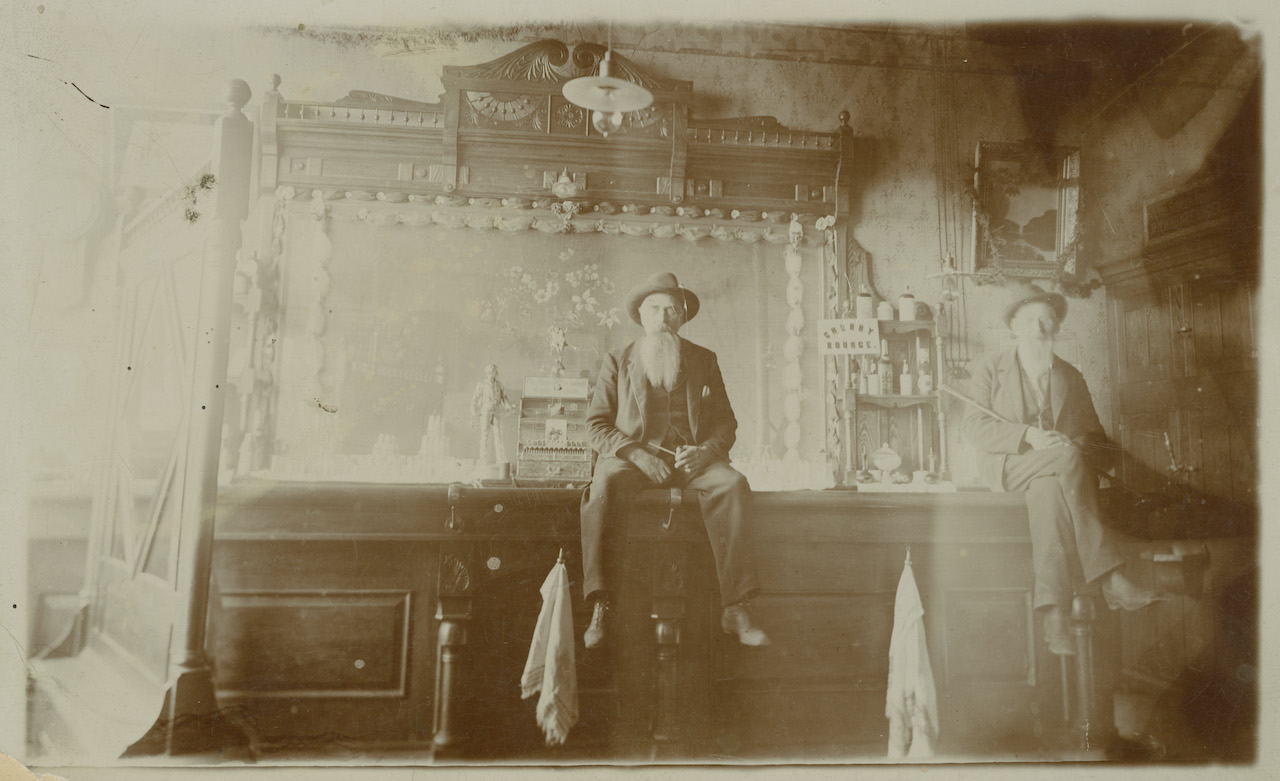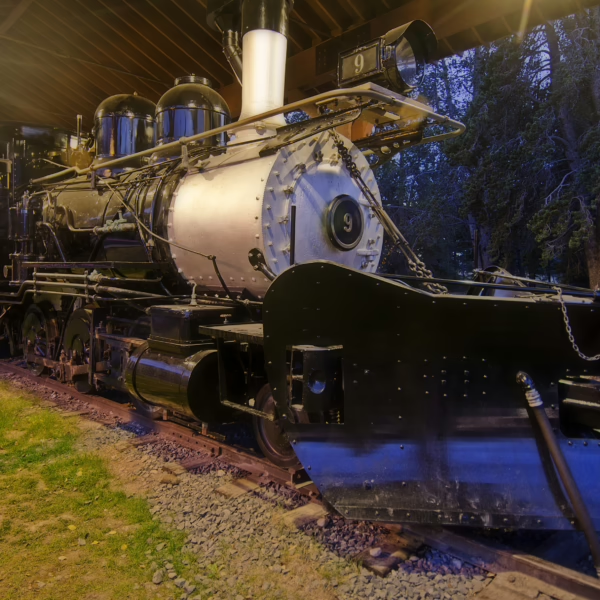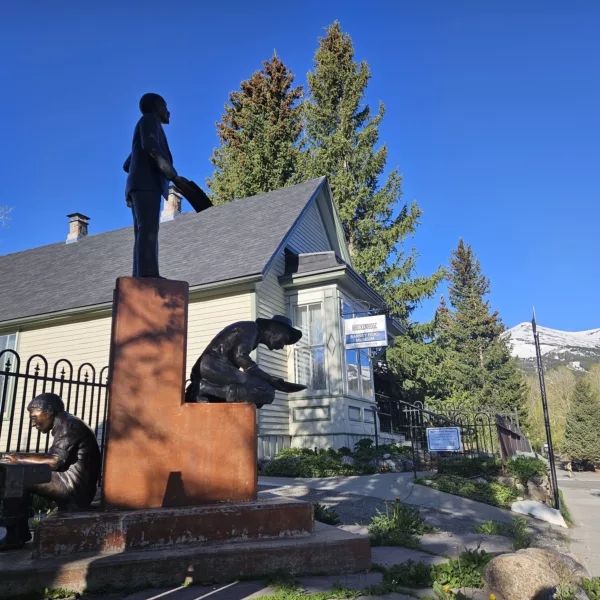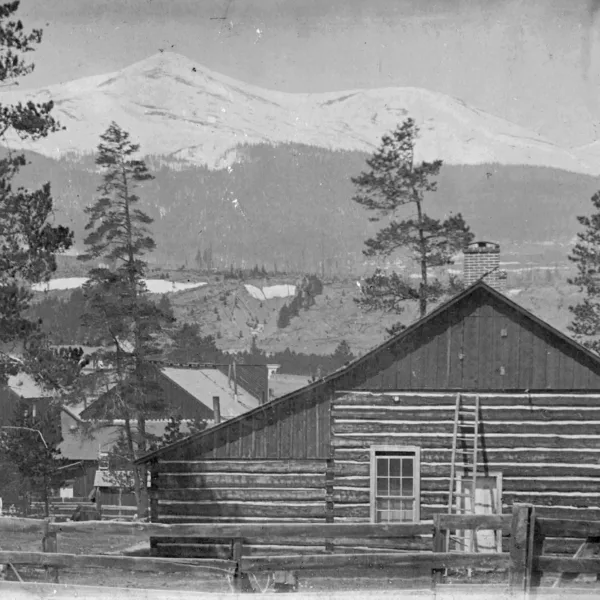Salones en Breckenridge
April 08, 2022 | Category: Historia de Breckenridge
 Probablemente ningún establecimiento comercial de la frontera minera desempeñó un papel más importante que la taberna. El whisky, el principal refresco que se vendía en los salones, llegó a lo que se convirtió en el condado de Summit durante el reinado de los montañeses (1820-1850). Cada otoño, tramperos y comerciantes se reunían en puntos de encuentro previamente designados, como LaBonte's Hole, en la confluencia de los ríos Blue River, Snake River y Ten Mile Creek, para intercambiar sus pieles por artículos necesarios para el próximo invierno, como pólvora, plomo para balas, rifles, cuchillos, café, azúcar, mantas y tabaco. Gran parte de lo que traían los comerciantes era whisky, y mucho.
Probablemente ningún establecimiento comercial de la frontera minera desempeñó un papel más importante que la taberna. El whisky, el principal refresco que se vendía en los salones, llegó a lo que se convirtió en el condado de Summit durante el reinado de los montañeses (1820-1850). Cada otoño, tramperos y comerciantes se reunían en puntos de encuentro previamente designados, como LaBonte's Hole, en la confluencia de los ríos Blue River, Snake River y Ten Mile Creek, para intercambiar sus pieles por artículos necesarios para el próximo invierno, como pólvora, plomo para balas, rifles, cuchillos, café, azúcar, mantas y tabaco. Gran parte de lo que traían los comerciantes era whisky, y mucho.
La primera mina de oro registrada en el río Blue se produjo el 10 de agosto de 1859. Sólo seis meses después, el Rocky Mountain News señalaba que a lo largo del Blue River había carromatos y tiendas de campaña, así como "almacenes, viviendas, comercios y salones". En 1866, Bayard Taylor contaba que en Breckenridge había disfrutado de una abundante comida acompañada de un barril de cerveza de barril.
Es posible que las primeras tabernas fueran vagones en los que se podía leer "taberna" o "whisky". Los barriles vacíos con una tabla encima podrían haber sido el primer "bar". Algunas tabernas funcionaban desde tiendas de campaña, un paso por encima de la venta de whisky desde carromatos. Puede que la estructura tuviera laterales de madera y un techo de lona en la parte superior. Las barras ornamentadas y talladas a mano aparecieron primero en salones situados en edificios de troncos y entramados de madera, a veces con una falsa fachada que ofrecía espacio para anunciar el negocio. Desde estos humildes comienzos, la taberna se convirtió rápidamente en un ornamentado establecimiento con espejos de polvo de diamante y whisky de verdad.
¿Por qué tantos salones? Principalmente, los salones reforzaban el ego masculino. Enfatizaban todos los rasgos masculinos de una población mayoritariamente masculina. También satisfacían una necesidad. En ellos, los hombres encontraban consuelo, un refugio contra la soledad. Los clientes preferían formar parte de la multitud en un saloon a pasar la noche en una solitaria cabaña de madera. Los saloons ofrecían un lugar donde comer, beber, dormir o simplemente relajarse. Los hombres podían apostar, bailar, intercambiar noticias y cotilleos, discutir temas locales y nacionales, cortarse el pelo, cumplir con sus obligaciones cívicas, votar en las elecciones, presentar reclamaciones, asistir a servicios religiosos, bodas o funerales, o recibir atención médica rudimentaria de médicos o dentistas visitantes. En algunos establecimientos, los hombres podían encontrar compañía femenina.
Las tabernas funcionaban a menudo como los primeros tribunales, en los que el tabernero hacía las veces de juez. Prevalecía el sentido común. Todo esto cambió con la intervención de los abogados, siempre presentes en los procedimientos. Las elecciones a los cargos municipales podían celebrarse en una taberna. Dado que los juzgados fueron uno de los primeros edificios cívicos construidos en una ciudad, los salones cubrieron esta necesidad durante poco tiempo. En algunos salones se alquilaban buzones, mientras que en otros se publicaban avisos de empleo y de otro tipo. Antes de que existieran los hospitales, las personas que sufrían una urgencia médica podían ser atendidas en una taberna. El whisky servía como anestésico. Como los hombres se mostraban reacios a abandonar las mesas de juego, los ministros les llevaban su mensaje a los salones. Después del servicio, los hombres pasaban el sombrero para conseguir "algo para el predicador". El padre Dyer lamentaba que los hombres prefirieran ir al bar a beber y jugar a las cartas, incluso en sábado. Algunas tabernas, como la de los hermanos Engle, en la esquina noreste de la avenida Lincoln y la calle Ridge, disponían de una caja fuerte ignífuga para sus clientes. Cuando se trataba de honradez, muchos preferían a los taberneros a los banqueros.
Algunos salones hacían las veces de hoteles, aunque el alojamiento y la comida podían ser bastante deficientes. Cuando se abrieron los hoteles "de verdad", el hotel/salón se convirtió en una taberna.
Aunque la centralidad e importancia de las tabernas fue disminuyendo a medida que se abrían juzgados, consultorios médicos, bancos, iglesias, logias, oficinas de correos, hoteles y restaurantes, las ciudades presumían del número de tabernas que atendían a sus habitantes. Un gran número indicaba la prosperidad de la ciudad. En 1880, Minnie Roby, esposa del comerciante John Roby, contaba 18 tabernas. Enumeró algunos de ellos: Weinberger and Brothers, licores y puros; Norris and Thornton Club Rooms; the Mammoth Circus Tent Club Rooms, Hodges and Staff; A. Cline and Company, mayoristas de licores. Los hoteles también vendían licores: Fisk's Hotel, Carbonate House, el National Hotel, el Arlington Hotel, el Denver Hotel y el Grand Central Hotel.
Para atraer a los clientes, los taberneros decoraban sus paredes con obras de arte. Mientras bebían, los hombres podían contemplar el retrato de una mujer desnuda, con forma de violín bajo, colgado encima de la barra. O podían ser carteles publicitarios de una determinada marca de cerveza o de un campeón de boxeo. O las cabezas de animales capturados durante una cacería. O carteles ingeniosos: beba y márchese tranquilamente.
Los anuncios llenaban los periódicos:
- "Para una goleta de gran cerveza ve a Hammerschlag's esta noche.
- Esta noche y mañana habrá un buen rato en la taberna Hammerschlag's Denver, en la calle South Main. George tiene la mejor cerveza y todo lo relacionado con su local es de primera clase.
- Billar, ¡oh sí! Si quieres una hora de diversión en esa línea déjate caer por el salón Grand Central, puedes encontrar mesas de comida, un lugar tranquilo, un caballero compañero, buenos puros y licores selectos.
- ¡Cerveza! ¡Cerveza! ¡Cerveza!
- Vinos de mesa, también tengo una buena línea de célebres vinos Kelly Island Catawba para la venta ahora al comercio, o en cantidad para uso de mesa, en el bar del Palace Saloon.
- Cóctel de lujo y otras bebidas mezcladas iguales a las mejores del país"
Los salones solían atender a grupos culturales concretos. El Palace Saloon acogió la Teutonia Leiderkranz, una sociedad de canto alemana.
El éxito de una taberna recaía sobre los hombros del camarero. P.S. Daigle, el barman del Hotel Denver, gozaba de una excelente reputación por mantener el "mejor y más limpio bar de la ciudad". Tenía "el mejor whisky de Kentucky y sus puros no tienen rival". Daigle es uno de los pocos hombres que saben llevar un bar". Los residentes tenían en alta estima a los taberneros y los incluían en el mismo grupo social que médicos, banqueros y editores de periódicos. La vestimenta de los taberneros evolucionó con el paso de los años, desde el atuendo tosco y desenfadado de las décadas de 1860 y 1870 hasta las camisas blancas, los chalecos y las joyas.
Los taberneros utilizaban muchos "trucos" para atraer clientes y aumentar el número de bebidas servidas. El primer trago después de un largo turno de un minero podía ser gratis; a veces, el primer trago del día era gratis. Por supuesto, algunos hacían la ronda por varias tabernas para conseguir esa "primera" bebida gratis. Los camareros animaban a "tratar". No sólo aumentaba la camaradería, sino también las ventas.
En los salones había una balanza de ensayador para medir el oro en polvo, el medio de intercambio. La frase "¿Cuánto puedes conseguir en un pellizco?" procedía de la frontera minera. Una pizca de polvo de oro entre el pulgar y el primer dedo equivalía a veinticinco céntimos. Muchas otras expresiones que aún se utilizan hoy en día proceden de la época minera. Una de ellas es "morder el polvo". El serrín cubría el suelo de muchos salones, lo que facilitaba la limpieza. Con el serrín se buscaba el oro que caía de los bolsillos o de los dedos. Cuando una persona bebía demasiado y caía al suelo, "mordía el (serr)polvo".
Los salones empezaron a ofrecer almuerzos sin comida en algunos; festines festivos en otros. Con la llegada del ferrocarril a principios de la década de 1880, los taberneros pudieron ofrecer frutas, verduras y carnes frescas transportadas en vagones refrigerados.
Las Habitaciones Doradas de Main Street mostraban la transición completa a un establecimiento que atendía a hombres de negocios. Una habitación tenía un elegante papel pintado dorado con "todo el entorno a juego". El periódico anunciaba otra habitación destinada al "uso privado de los caballeros clientes, amueblada con material de escritura, papelería, etc.".
Weaver Brothers Corner Saloon, en la intersección de Main Street y Lincoln Avenue, señalaba que sus bebidas eran "seductoras pero rara vez embriagadoras".
Con el tiempo, el ambiente de las ciudades mineras como Breckenridge cambió. Desapareció el rudo individualismo de los prospectores independientes y los mineros de placer (plă' ser). Las grandes empresas compraron a los particulares; económicamente era mejor consolidar las explotaciones. Ahora los mineros trabajaban para otros -siete días a la semana, turnos de diez horas- en lugar de para sí mismos. La taberna ya no funcionaba como el dominio del minero entusiasta que esperaba un golpe de suerte. Los días de juerga se desvanecen en la memoria. Las logias, las organizaciones fraternales, los partidos políticos, las sociedades literarias y las salas de lectura atraían a los clientes de los salones, sustituyendo la bebida y el juego por actividades más tranquilas. Cada vez más, entre los clientes había hombres de empresa que hablaban de economía mundial, prácticas mineras, nueva maquinaria y problemas laborales.
Las grandes empresas disfrutaron de la ventaja de la financiación de los inversores, aunque puede que la inversión no se hiciera de forma inteligente. Residentes y comerciantes preferían esta nueva respetabilidad que conduciría a la prosperidad, el objetivo final de todos.
escrito por Sandra F. Mather, PhD




